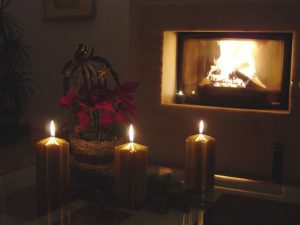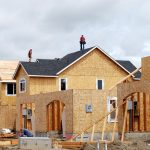
It is FINALLY starting to cool off here in Prescott, Arizona! As a home inspector (providing inspections in the Prescott area as well the Phoenix metro area) I see some fireplaces used in an unsafe manner. So I wanted to use this time to help educate you on what you should and shouldn’t use your fireplaces for, and what type of fireplace fuel is best. Stay safe this holiday season!
Fireplaces and wood stoves are designed to burn only one type of fuel. Used as all-purpose incinerators, these devices can pose the following hazards:
- Harmful vapors can vent into the living space. Even the most efficient fireplaces will vent directly into the living space while they’re opened and closed for cleaning and refueling, exposing everyone in the house to potentially dangerous fumes.

- Harmful vapors will vent to the outdoors. Most newer fireplaces and wood stoves do an excellent job of funneling smoke and fumes to the outdoors, but the problem doesn’t end there; this pollution persists, contaminating household and environmental air.
- Burning inappropriate fuel can cause mechanical damage. Chimneys can become lined with residue from inappropriate items, which may lead to a dangerous chimney fire. The fumes from certain items will quickly wear out sensitive components, such as catalytic combustors in wood stoves.
Read the following guidelines to better understand what can and cannot be safely burned in a residential fireplace or wood stove.
What can be burned in a fireplace?
- dried, cut firewood. An adequate fuel supply will consist of a mixture of hardwoods, such as maple and oak, and softwoods, such as fir and pine. Softwoods ignite quickly and are useful in the early stages of the fire, while hardwoods provide a longer-lasting fire, and are best used after preheating the chimney. Despite the different burning characteristics of hardwoods and softwoods, which can be attributed to differences in density, the heat-energy released by burning wood is the same, regardless of species. To dry out wood, it should be stacked in an open area so the sun can warm the pieces and the breezes can carry away the moisture. Poplar, spruce and other softwoods generally dry quickly, as do wood that has been split small. Adequately seasoned wood has a moisture content of less than 20%, which can be checked using the following indicators:
- The wood has darkened from white or a cream color to yellow or grey.
- There are cracks or checks in the end grain.
- A hollow sound is produced when two pieces of wood are banged together.
- You can split a piece and feel if the new surface is damp or dry.
- The wood does not hiss while burning.
- You can check its moisture content with a moisture meter.

- pallets. Generally, pallets are safe to burn in fireplaces, although those that are treated with the fumigant methyl bromide (labeled with the initials MB) are unsafe to burn. Also, pallets may have been exposed to a variety of chemicals while they were in use. Aside from these concerns, pallets produce a hot flame because they’re usually very dry and their segments are thin. Be careful to check for nails while cutting pallets, as they may damage a saw blade. You may also wind up with nails in your ash, which should be disposed of far from roads and driveways.
- fallen tree limbs. These can generally be collected and used for kindling, provided they have been given time to dry.
- wood collected from housing developments. If it is truly trash and not someone’s property (including the housing contractor’s), using scavenged wood that has been cleared away for housing developments is good for burning. Try to obtain it before the non-lumber grade wood is pushed into massive piles and burned as a means of disposal by the contractor.
- fire logs. These artificial logs burn relatively cleanly and release less ash than their natural wood counterparts.
What should never be burned in a fireplace?
- painted wood. Paint contains heavy metals, such as lead, chromium and titanium, which are used to make the different colors. These metals, especially lead, can be toxic even in small quantities if inhaled. If you’re unsure if your paint has lead, be sure to consult with your InterNACHI inspector during your next scheduled inspection.
- pressure-treated wood. Wood is commonly made resistant to fungus and insects through the addition of copper, chromate and arsenic, in a process known as CCA treatment. CCA treatment places roughly 27 grams of arsenic in every 12-foot 2×6, which is sufficient to kill about 250 adults, which is why it is illegal in the U.S. to burn pressure-treated wood. Vaporized CCA wood, known as fly ash, is extremely toxic; in one case, as reported by the American Medical Association, a family was stricken with seizures, hair loss, debilitating headaches, blackouts and nosebleeds from fly ash released when they unknowingly used CCA wood to burn in their fireplace. Even the family’s houseplants and fish succumbed to the toxic fumes.
- plywood, particleboard, chipboard or OSB. These manmade woods release formaldehyde, and potentially hydrochloric acid or dioxin, when burned. Some states have outlawed the incineration of some or all of these artificial wood products.
- rotted, diseased or moldy wood. This wood will not burn as long as normal wood, may produce bad smells when burned, and could bring insects into the house.
- damp wood. Wood that has a moisture content higher than 20% will burn inefficiently and will contribute to a greater accumulation of creosote in the chimney, as well as air pollution.
- allergenic plants. Urushiol, which is the chemical that induces the typically minor allergic reaction when skin is exposed to poison ivy, poison sumac or poison oak, is far more dangerous when inhaled. Urushiol is not destroyed by fire and can quickly cause life-threatening respiratory distress if any of these plants are burned.
- dryer lint. While it’s often used effectively as a fire-starter, lint can contain a wide array of dangerous chemicals that come from your clothes and fabric softener.
- trash. Never burn household garbage, as it contains a range of potentially hazardous materials and chemicals that react in unpredictable ways when burned together. Newspaper ink, plastics, aluminum foil, plastic baggies, and whatever else constitutes your particular trash can create a deadly chemical cocktail.
- driftwood. Wood found on the beach of an ocean or salty lake will release salt when burned, which will quickly corrode any metal and etch the glass of a wood stove or fireplace. Catalytic converters are especially vulnerable to salt corrosion. In addition to potential damage to the stove or fireplace, the EPA claims that driftwood releases toxic chemicals when burned.
